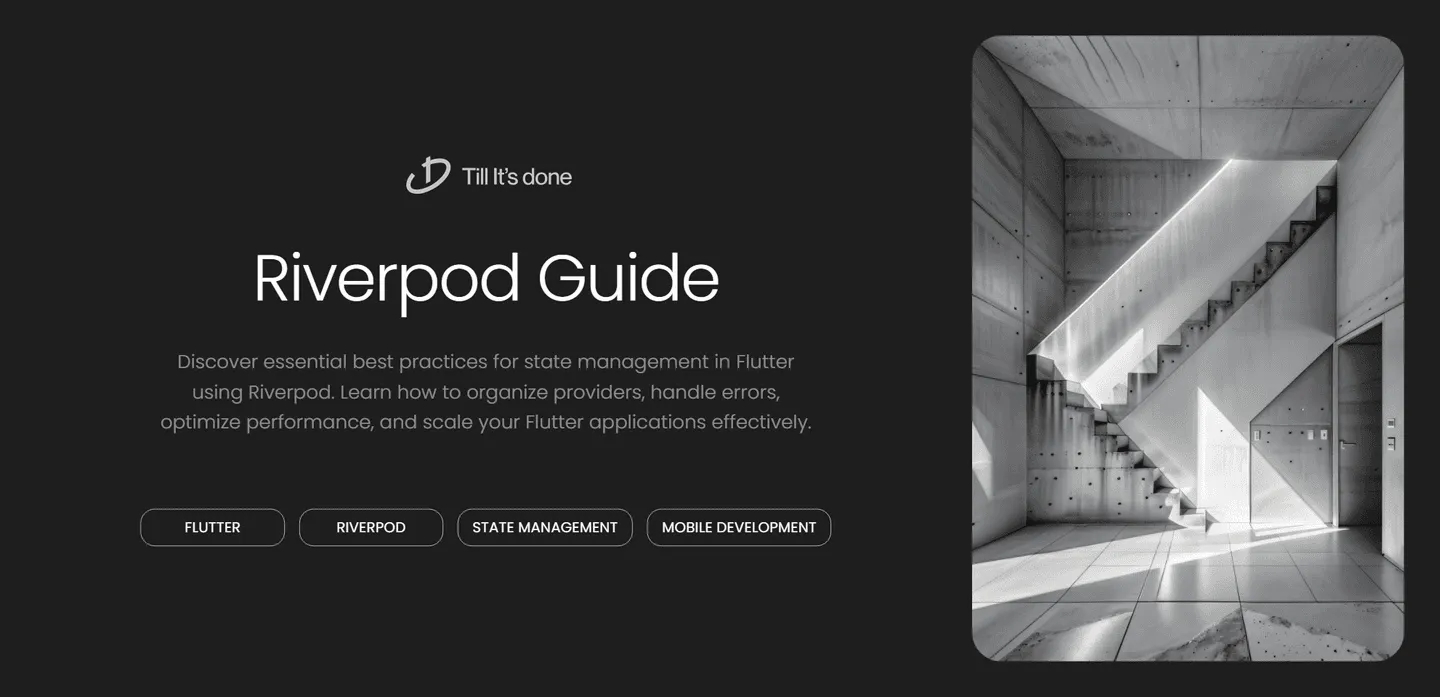- Services
- Case Studies
- Technologies
- NextJs development
- Flutter development
- NodeJs development
- ReactJs development
- About
- Contact
- Tools
- Blogs
- FAQ
Flutter Riverpod State Management Guide
Learn how to organize providers, handle errors, optimize performance, and scale your Flutter applications effectively.

State Management in Flutter with Riverpod: Best Practices

State management is one of the most crucial aspects of building robust Flutter applications. While Flutter offers several state management solutions, Riverpod has emerged as a powerful and intuitive option that addresses many common development challenges. Let’s dive into the best practices for managing state with Riverpod in your Flutter applications.
Understanding Riverpod’s Core Concepts
Before we explore best practices, it’s essential to understand what makes Riverpod special. Riverpod is a complete rewrite of the Provider package, designed to be more type-safe, maintainable, and testable. It removes many of the limitations found in traditional InheritedWidget patterns while maintaining simplicity.

Key Best Practices
1. Provider Organization
Always organize your providers in a dedicated directory structure. Consider grouping related providers in separate files:
lib/ ├── providers/ │ ├── auth_providers.dart │ ├── user_providers.dart │ └── settings_providers.dart2. Use Provider Types Wisely
Choose the right provider type for your specific use case:
Provider: For plain values and dependenciesStateProvider: For simple state that can be modifiedStateNotifierProvider: For complex state managementFutureProvider: For async dataStreamProvider: For reactive data streams
3. Leverage Provider Modifiers
Take advantage of Riverpod’s modifier methods to enhance your providers:
final userProvider = FutureProvider.autoDispose.family<User, String>((ref, userId) { return fetchUser(userId);});
4. State Immutability
Always treat state as immutable. When using StateNotifier, create new state instances instead of modifying existing ones:
class TodosNotifier extends StateNotifier<List<Todo>> { TodosNotifier() : super([]);
void addTodo(Todo todo) { state = [...state, todo]; // Create new list instead of using add() }}5. Error Handling
Implement proper error handling in your providers:
final apiProvider = FutureProvider<Data>((ref) async { try { return await api.fetchData(); } catch (e) { throw CustomException('Failed to fetch data: $e'); }});6. Testing Considerations
Make your providers testable by:
- Keeping providers small and focused
- Using override for dependency injection
- Creating mock providers for testing
7. Performance Optimization
Optimize your app’s performance by:
- Using
selectto listen to specific state changes - Implementing
autoDisposefor temporary providers - Avoiding unnecessary rebuilds with careful provider design
8. Code Organization and Scalability
As your app grows:
- Create provider interfaces for better abstraction
- Use provider families for parameterized providers
- Implement proper dependency injection patterns
Conclusion
Riverpod offers a robust and flexible state management solution for Flutter applications. By following these best practices, you can create maintainable, scalable, and efficient apps while avoiding common pitfalls in state management.

 สร้างเว็บไซต์ 1 เว็บ ต้องใช้งบเท่าไหร่? เจาะลึกทุกองค์ประกอบ website development cost อยากสร้างเว็บไซต์แต่ไม่มั่นใจในเรื่องของงบประมาณ อ่านสรุปเจาะลึกตั้งแต่ดีไซน์, ฟังก์ชัน และการดูแล พร้อมตัวอย่างงบจริงจาก Till it’s done ที่แผนชัด งบไม่บานปลายแน่นอน
สร้างเว็บไซต์ 1 เว็บ ต้องใช้งบเท่าไหร่? เจาะลึกทุกองค์ประกอบ website development cost อยากสร้างเว็บไซต์แต่ไม่มั่นใจในเรื่องของงบประมาณ อ่านสรุปเจาะลึกตั้งแต่ดีไซน์, ฟังก์ชัน และการดูแล พร้อมตัวอย่างงบจริงจาก Till it’s done ที่แผนชัด งบไม่บานปลายแน่นอน  Next.js สอน 14 ขั้นตอนเบื้องต้น: สร้างโปรเจกต์แรกใน 30 นาที เริ่มต้นกับ Next.js ใน 14 ขั้นตอนเพียงแค่ 30 นาที พร้อม SSR/SSG และ API Routes ด้วยตัวอย่างโค้ดง่าย ๆ อ่านต่อเพื่อสร้างโปรเจ็กต์แรกได้ทันทีที่นี่
Next.js สอน 14 ขั้นตอนเบื้องต้น: สร้างโปรเจกต์แรกใน 30 นาที เริ่มต้นกับ Next.js ใน 14 ขั้นตอนเพียงแค่ 30 นาที พร้อม SSR/SSG และ API Routes ด้วยตัวอย่างโค้ดง่าย ๆ อ่านต่อเพื่อสร้างโปรเจ็กต์แรกได้ทันทีที่นี่  วิธีสมัคร Apple Developer Account เพื่อนำแอปขึ้น App Store ทีละขั้นตอน อยากปล่อยแอปบน App Store ระดับโลก มาอ่านคู่มือสมัคร Apple Developer Account พร้อมเคล็ดลับ TestFlight และวิธีอัปโหลดที่ง่ายในบทความเดียวนี้ได้เลย
วิธีสมัคร Apple Developer Account เพื่อนำแอปขึ้น App Store ทีละขั้นตอน อยากปล่อยแอปบน App Store ระดับโลก มาอ่านคู่มือสมัคร Apple Developer Account พร้อมเคล็ดลับ TestFlight และวิธีอัปโหลดที่ง่ายในบทความเดียวนี้ได้เลย  TypeScript Interface คืออะไร? อธิบายพร้อมวิธีใช้และข้อแตกต่างจาก Type เรียนรู้วิธีใช้ TypeScript Interface เพื่อสร้างโครงสร้างข้อมูลที่ปลอดภัยและเข้าใจง่าย พร้อมเปรียบเทียบข้อดีข้อแตกต่างกับ Type ที่คุณต้องรู้ ถูกรวมเอาไว้ในบทความนี้แล้ว
TypeScript Interface คืออะไร? อธิบายพร้อมวิธีใช้และข้อแตกต่างจาก Type เรียนรู้วิธีใช้ TypeScript Interface เพื่อสร้างโครงสร้างข้อมูลที่ปลอดภัยและเข้าใจง่าย พร้อมเปรียบเทียบข้อดีข้อแตกต่างกับ Type ที่คุณต้องรู้ ถูกรวมเอาไว้ในบทความนี้แล้ว  Material-UI (MUI) คืออะไร อยากสร้าง UI สวยงามและเป็นมืออาชีพในเวลาอันรวดเร็วใช่ไหม มาทำความรู้จักกับ Material-UI (MUI) ที่ช่วยให้คุณพัฒนาแอปพลิเคชันบน React ได้ง่ายและดูดีในทุกอุปกรณ์
Material-UI (MUI) คืออะไร อยากสร้าง UI สวยงามและเป็นมืออาชีพในเวลาอันรวดเร็วใช่ไหม มาทำความรู้จักกับ Material-UI (MUI) ที่ช่วยให้คุณพัฒนาแอปพลิเคชันบน React ได้ง่ายและดูดีในทุกอุปกรณ์  เปรียบเทียบ 3 วิธีติดตั้ง install node js บน Ubuntu: NVM vs NodeSource vs Official Repo แบบไหนดีที่สุด? เรียนรู้วิธีติดตั้ง Node.js บน Ubuntu ด้วย NVM, NodeSource หรือ Official Repo เลือกวิธีที่เหมาะกับความต้องการของคุณ พร้อมเปรียบเทียบ เพื่อการพัฒนาที่มีประสิทธิภาพ!
เปรียบเทียบ 3 วิธีติดตั้ง install node js บน Ubuntu: NVM vs NodeSource vs Official Repo แบบไหนดีที่สุด? เรียนรู้วิธีติดตั้ง Node.js บน Ubuntu ด้วย NVM, NodeSource หรือ Official Repo เลือกวิธีที่เหมาะกับความต้องการของคุณ พร้อมเปรียบเทียบ เพื่อการพัฒนาที่มีประสิทธิภาพ! Talk with CEO
We'll be right here with you every step of the way.
We'll be here, prepared to commence this promising collaboration.
Whether you're curious about features, warranties, or shopping policies, we provide comprehensive answers to assist you.


